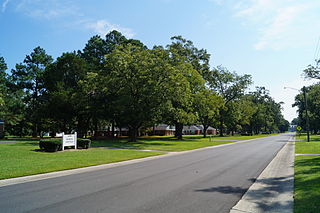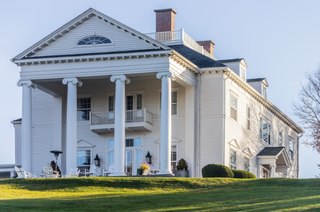
Blowing Rock is a town in Watauga and Caldwell counties in the U.S. state of North Carolina. The population was 1,397 at the 2021 census.

The Alice Freeman Palmer Memorial Institute, better known as Palmer Memorial Institute, was a school for upper-class African Americans. It was founded in 1902 by Dr. Charlotte Hawkins Brown at Sedalia, North Carolina near Greensboro. The institute was named after Alice Freeman Palmer, former president of Wellesley College and benefactor of Dr. Brown.

Edenton Historic District is a national historic district located at Edenton, Chowan County, North Carolina. The district encompasses 342 contributing buildings, 4 contributing sites, and 3 contributing structures. It includes several buildings that are individually listed on the National Register. The Lane House, possibly the oldest surviving house in North Carolina, is owned by Steve and Linda Lane and is located within the district. Also located in the district are the Dixon-Powell House, William Leary House, and Louis Ziegler House designed by architect George Franklin Barber.

The High Hampton Inn Historic District is a historic estate, resort, and national historic district nestled in the mountains of western North Carolina, in the Cashiers Valley in Jackson County, North Carolina. Originally the summer home of the prosperous Hampton family of South Carolina, the property was listed on the National Register of Historic Places in 1991.

Flat Rock Historic District is a national historic district located at Flat Rock, Henderson County, North Carolina. The district encompasses 55 contributing buildings and 1 contributing site associated with estates centering on the ambitious summer houses of the prominent Charlestonians. The homes includes notable examples of Stick Style / Eastlake movement, Second Empire, and Gothic Revival residential architecture. Located in the district is the separately listed Carl Sandburg Home National Historic Site, also known as Connemara. Other notable estates include Mountain Lodge, Argyle, Beaumont, Tall Trees (Greenlawn), Many Pines, Chanteloupe, Teneriffe, Rutledge Cottage, Dunroy, Treholm-Rhett House home of George Trenholm, Kenmure (Glenroy), Vincennes home of William Elliott, Sallie Parker House, Enchantment, Bonclarken (Heidleberg), Saluda Cottages, Tranquility, and the Rhue House. Also located in the district is St. John-in-the-Wilderness church and rectory, the Old Post Office, Woodfield Inn, The Lowndes Place.

Hillsborough Historic District is a national historic district located at Hillsborough, Orange County, North Carolina. The district encompasses 529 contributing buildings, 9 contributing sites, 13 contributing structures, and 2 contributing objects in the central business district and surrounding residential sections of Hillsborough. The district includes buildings dating to the late-18th and early-20th century and includes notable examples of Federal, Greek Revival, and Italianate style architecture. Located in the district are the separately listed Burwell School, Eagle Lodge, Hazel-Nash House, Heartsease, Montrose, Nash Law Office, Nash-Hooper House, Old Orange County Courthouse, Poplar Hill, Ruffin-Roulhac House, Sans Souci, and St. Matthew's Episcopal Church and Churchyard. Other notable buildings include Seven Hearths, the Presbyterian Church (1815-1816), Methodist Church (1859-1860), First Baptist Church (1862-1870), Twin Chimneys, and the Berry Brick House.

Halifax Historic District is a national historic district located at Halifax, Halifax County, North Carolina, US that was listed on the National Register of Historic Places in 1970. It includes several buildings that are individually listed on the National Register. Halifax was the site of the signing of the Halifax Resolves on April 12, 1776, a set of resolutions of the North Carolina Provincial Congress which led to the United States Declaration of Independence gaining the support of North Carolina's delegates to the Second Continental Congress in that year.

Linville Historic District is a historic school campus and national historic district located at Linville, Avery County, North Carolina. It encompasses 96 contributing buildings and 4 contributing structures in the historic core of Linville. The buildings date between about 1892 and 1940, and include shingle-or chestnut bark-covered resort buildings and the second generation of houses flanking the first and eighteenth fairways of the golf course. Notable buildings include the Hemlock Cottage, Dormiecroft, "Honeymoon" Cottage, Presbyterian Church, The Studio, the VanLandingham House, and All Saints Episcopal Church.

Manor and Cottages is a historic resort complex and national historic district located in the Albemarle Park neighborhood in Asheville, Buncombe County, North Carolina. The complex encompassed 36 contributing buildings that were built starting in 1898. The main hotel, The Manor, was built starting in 1898–1899, and consists of a rambling group of interconnected wings with elements of the Colonial Revival, Shingle Style, and Tudor Revival styles. Wings were added to the original building in 1903 and 1913–1914. Located on the property are the contributing Club House and a 19 guest cottages built between 1899 and 1920. The hotel was later converted for use as a retirement hotel for elderly persons with limited incomes.

Sunset Terrace Historic District is a national historic district located at Asheville, Buncombe County, North Carolina. The district encompasses nine contributing buildings in a residential section of Asheville. The property was developed after 1913, and includes representative examples of Tudor Revival and Bungalow style dwellings. Notable dwellings include the Rosemary Cottage (1913), Primrose Cottage (1913), Rambler Cottage (1915), Westview Cottage (1915), and Violet Cottage (1920).

Blue Ridge Assembly Historic District is a national historic district located near Black Mountain, Buncombe County, North Carolina. The district encompasses 29 contributing buildings and 1 contributing object associated with the Blue Ridge Assembly, conference center of the Young Men's Christian Association. The main building is Eureka Hall designed by Louis E. Jallade. It was built in 1911–1912, and is a three-story, seven-bay, frame building with a full-height octastyle portico. Also located on the large central courtyard are the Gymnasium, Asheville Hall (1926), Abbott Hall (1927), and College Hall. Other notable buildings include the Martha Washington Residence, Craft and Child Care Center, and 19 frame cottages (1913–1927). Black Mountain College was founded here in 1933 and operated on the site until 1941.

North Green Street–Bouchelle Street Historic District is a national historic district located at Morganton, Burke County, North Carolina. It encompasses 37 contributing buildings in a predominantly residential section of Morganton. It includes buildings built between about 1876 and 1935, and includes representative examples of Colonial Revival, Bungalow / American Craftsman, and Late Victorian style architecture. Located in the district is the separately listed Alphonse Calhoun Avery House.

Nags Head Beach Cottages Historic District, also known as the Nags Head Beach Cottage Row Historic District, is a national historic district located at Nags Head, Dare County, North Carolina. The district encompasses 41 contributing buildings dating from the late-19th and early-20th century. The district is characterized by a string of frame wood-shingled cottages and includes notable examples of Late Gothic Revival and Queen Anne style architecture.

Rosemount–McIver Park Historic District is a national historic district located at Sanford, Lee County, North Carolina. It encompasses 169 contributing buildings, 1 contributing site, and 1 contributing structure in two residential neighborhoods of Sanford. The district includes notable examples of Colonial Revival, Tudor Revival and Queen Anne style architecture, with buildings largely dated between about 1900 to the early 1940s. The houses are characterized as one story, story-and-a-half, or two stories in height, ranging in scale from compact bungalows and cottages to manorial residences.

Kennedy Memorial Home Historic District, also known as Cedar Dell, is a historic farm and national historic district located near Kinston, Lenoir County, North Carolina. It encompasses 29 contributing buildings, 7 contributing sites and 5 contributing structures. The district includes an orphanage owned by the Baptist Children's Homes of North Carolina and constructed from 1914 to 1959. Located in the district is the separately listed Federal style Cedar Dell plantation home. Other contributing resources are the Jar Room/Shop (1920s), potato curing barn (1920s), Pollock Cottage (1936), Kennedy Memorial Home Baptist Church (1956), Jones Swimming Pool (1957), Cedar Dell Cemetery (1830s-1929), and Brogden Food Locker (1950s).
Masonboro Sound Historic District is a national historic district located near Wilmington, New Hanover County, North Carolina. The district encompasses 22 contributing buildings, 2 contributing sites, 8 contributing structures, and 1 contributing object near Wilmington. The district developed during the 19th and early-20th century and includes notable examples of Italian Renaissance and Colonial Revival style architecture. There are 10 contributing dwellings and 13 contributing outbuildings. Notable dwellings include the Carr-Ormand House (1932), Willard-Sprunt-Woolvin House (1880), Cazaux-Williams-Crow House, Parsley-Love House, Live Oaks (1913), Taylor-Bissinger House (1937), the "Doll House" (1924), and Hill-Anderson Cottage.
Glen Royall Mill Village Historic District is a historic mill town and national historic district located at Wake Forest, Wake County, North Carolina. The district encompasses 82 contributing buildings and 1 contributing site built between about 1900 and 1949. It is located in a residential section of the town of Wake Forest. There are notable examples of Bungalow / American Craftsman style architecture. Located in the district is the separately listed Royall Cotton Mill Commissary. Other notable buildings include the Royall Cotton Mill (1899-1900), the Powell-White House (1909-1910), and pyramidal cottages, triple-A cottages, and shotgun houses.

Westglow, also known as the Elliott Daingerfield House, is a historic home located near Blowing Rock, Watauga County, North Carolina. It was built in 1917, and is a 2+1⁄2-story, rectangular, Colonial Revival style frame dwelling with a hipped roof. It has a two-story hip roof extension. The front facade features a monumental tetrastyle portico supported by columns with Ionic order capitals. Also on the property are the contributing artists studio and caretaker's cottage (1920s). It was the summer home and studio of artist Elliot Daingerfield (1859-1932).

Vardell Family Cottages Historic District are three historic summer homes and national historic district located at Blowing Rock, Watauga County, North Carolina. They are Opicherhoka (1899-1900), Hemlock Cottage, and The Shoe (1933). Opicherhoka is a picturesque two-story, weatherboarded frame Arts and Crafts-style dwelling. Hemlock Cottage is a small rectangular, plainly-finished, weatherboarded, frame cottage. It consists of a two-story, two-room main block, a one-story shed roof front porch, and a gable roof ell. The Shoe is a small rectangular Arts and Crafts style one-story-with-loft frame cottage.
The former Randall Memorial Building, also known as the Village Cafe, is a historic commercial building located at Blowing Rock, Watauga County, North Carolina. It was built in 1907, and is a 1 1/2-story, weatherboarded cottage with steep gable roof. It has a one-story hip roofed wing. It was built by the local Episcopal Church congregation to serve as a workshop and training center for mountain handicrafts. It later served as a community centre.






















